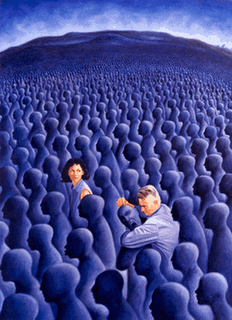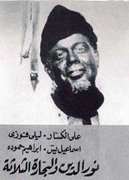
There is much disagreement concerning the status and future of psychoanalysis in the United States at this time. I believe, however, that many who argue that psychoanalysis is irrelevant or outmoded are misguided. Most of these negative voices arise from outside psychoanalysis. There are real questions about whether psychoanalysis can survive in the current cultural and economic climate without sacrificing or corrupting its basic or essential core. Within American psychoanalysis, however, there is an emerging generation who are reenergizing and expanding that essential core. They are engaged in new discoveries and a simultaneous rediscovery of their psychoanalytic roots. A new psychoanalytic synthesis is the result - an integration and possible consensus that appears to be rising in the aftermath of the psychoanalytic paradigm wars of the seventies and eighties.
There is much excitement within psychoanalysis in the United States today. Everyone seems to be talking to everyone else more freely and with greater comprehension and mutual edification than was the case only a short time ago. The dialogue and reflection that lies at the heart of the psychoanalytic enterprise and value system seems, almost miraculously, gradually to be asserting itself within psychoanalysis - where only misunderstanding and attacks among competing factions formerly existed. I greet these developments with pleasure and relief. It is wonderful to participate in this emerging synthesis and consensus, which provides compatible new conceptual language to help me systematize what had formerly been an uneasy and sometimes difficult to articulate, intuitive personal synthesis.
The buzzwords of this emerging generation are intersubjectivity and interaction. It is hard to separate completely or define these two terms in relation to each other, as they are actually differing vantage points on the same thing - the fact that there are two persons who are affecting each other involved in the field that is analyzed while doing psychoanalysis. Thus, we now speak of a two-person rather than one-person psychology. I think of intersubjectivity as stressing a psychic field constructed from two psychic realities or internal worlds in interplay with each other, including the unconscious fantasy life and empathic or containing capacities of both participants. Each becomes part of the psychic reality of the other. Thus when I think of intersubjectivity I imagine what each participant is for the other.
The overlapping vantage point of interaction stresses a live relationship between two real persons doing things together that are meaningful. Thus when I think of interaction, I imagine what each participant does for, to, or with the other. The difference between these two vantage points may be quite meaningless in the average clinical situation. For example, it might not matter whether one conceives that one participant has become ("is") an attacking internal object in the psychic reality of the other or conceives that one person in the room is actually attacking ("does to") the other and possibly disavowing that this is the case. These allegedly different ways of conceptualizing experience that is alive and has impact for both parties seem imprecise at times because of our imprecise way of conceptualizing action in psychoanalysis. Those who claim to follow Freud in sharply distinguishing actions from words or thoughts do not do justice to the complexity of the subject, a complexity, by the way, of which Freud was fully aware. In any event, interaction stresses what is happening between two persons and is "outside". Intersubjectivity stresses what is happening in the two minds of the participants and is usually thought of as "inside". All contemporary schools, however, seem to use and enjoy the current term for meaningful activity between analyst and analysand, which is "enactment". Many generative discussions about theoretical and clinical similarities and differences among and within the various schools are focused around this increasingly useful and unifying theoretical concept.
Taken all together, many of the most invigorating ideological trends of recent years seem to have coalesced into an entity in this country that is now called "relational". As with many invigorating new ideas in any field, these theorists define themselves and their new ground in relation to what is older and more traditional. In this country, this meant that advocates of the so-called relational schools have tended to define their psychoanalysis in comparison and contrast to that of the old order, which was called mainstream or "classical" psychoanalysis. Many of the values and techniques embodied by these relational schools have always been congenial to me. My so-called classical affinities became visible to me only gradually. I was trained in an institute whose identity was forged in breaking away from Freudian and ego-psychological orthodoxy in the forties. I trained in the late sixties, and object-relational, self-psychological, and developmental models were prominent and influential in my training. Kernberg, Kohut, and Winnicott were the most powerful figures for me when I was forging my psychoanalytic identity.
Later, Hans Loewald and Roy Schafer were major mentors and models. Although they broke with the ego-psychological traditions in which they were trained, their struggles with traditional theory led me to value those traditions on my own. Observations of their clinical work made me want to emulate the values and techniques embodied in that work. Both men, of course, were prominent and influential participants in the challenges to the old metapsychology of the sixties and seventies, out of which the relational movement emerged. But despite their compatibility (on my reading) with the relationalists and relational values, I still found at the center of their value system the "classic" emphasis on interpretation, insight, and understanding - on knowledge and knowing. You will recall I spoke earlier of my impression that the central vantage point of intersubjective approaches concerns what one is, while interactional approaches concern what one does. For me, the "traditional" vantage point supplies a third absolute essential to the analytic process, the vantage point of what one knows. I will say more about this essential triumvirate of being, doing, and knowing and how all three structure my personal analytic synthesis in a moment. I cannot retrace these influences in any detail here, but Loewald and Schafer’s models helped me see that there were ways of thinking about how the mind became structuralized that were structural in a contemporary sense, without the old constraints imposed by models that were mechanical, energic, or materialistic, or which lent themselves to reification.
In large measure because of the influence of such thinkers, I came to think of the mind as innately motivated to develop, to become more highly organized, to differentiate and integrate. Ultimately I was able to retain the useful ego-psychological concept of psychic structure or of "structuralization" as a metaphor for the evolving, maturing individual mind in development and in treatment. Of course, most contemporary psychoanalysts now take for granted that the symbolic function and the representational world are what is structured in structuralization, not instinctual energies or "ego-superego relations", conceived as abstract, reified, or isolated entities. What is structured is personal experience and personal meanings. We also now intuitively regard the capacity to synthetize and integrate increasingly more finely discriminated aspects of internal and external reality as the obverse of neurotic distortion. Differentiation and integration is what takes place when neurotic constraints are removed and development resumed - perspective perhaps, but not simple "objectivity". A more integrated, structuralized mind searches out and more easily assimilates new and more highly refined experience, promotes further creative mastery and growth. In development and in treatment, this process is fatefully immersed and shaped in an intersubjective and interpersonal field. Relational theory has provided unprecedented new theoretical tools to consider the crucial parts played by the analyst’s subjectivity and full participation in a rich two-person relationship, but the participants have different tasks, constraints, and responsibilities. Traditional theory retains many advantages for thinking about these crucial differences, and for not losing focus on the patient and the patient’s mental life as the essential object of psychoanalysis.
The emerging synthesis which blends relational and traditional perspectives allows a modern psychoanalyst to utilize the three perspectives - intersubjective, interactional, and traditional - and to take advantage of the increasingly obvious fact that no single viewpoint argues against the validity of the others. Each has clinical advantages and disadvantages, each foregrounds certain phenomena and lets other fall through its theoretical cracks. Each appeals to persons with particular styles or values, and each has typical blind spots and countertransferences. Most analysts today have learned from and use all of these traditions. I believe that the mythic classical analyst, with his or her fierce and forbidding authority, distance, and cocksure Freudian formulas is and should be a fast fading breed. As I said, each so-called "school" has its typical strengths and countertransferences.
For example, Kleinians and Sullivanians are bold and fearless in using themselves and mixing it up with difficult characters, but sometimes reckless and aggressive interpretively. They sometimes therefore mistake their own countertransference fantasies for revealed truth about the patient. Self psychologists and others who stress empathy or containment functions are the most compassionate, nonjudgemental, and self-scrutinizing, but may sometimes be naive about aggression. They may also sometimes therefore be cautious or timid about drawing necessary limits or forcing patients to face their own responsibilities for their fates. Ego psychologists - classic American "Freudian" - walk a well reasoned middle path, are the most scrupulous to avoid wild analysis and love cures, and are the keepers of the curative power of insight. They may also therefore sometimes be overly cerebral, emotionally constrained, and intellectually arrogant. I think that these traditions represent three polarities that all therapists must know about.
One way to think of them, respectively, are as paths of action, feeling, and insight, or, as I said earlier, traditions of doing, being, and knowing. Any one in isolation from the other two will be shallow, and usually when one is truly or deeply present, so are the others. Fearless interpersonal engagement, compassionate regard for authenticity and the patient’s own being, and a passion for reflection and capacity for nonintrusiveness and constraint should exist in the value system of every psychoanalyst. Additionally, every psychoanalyst must learn the strenghts and limits of his or her own personality and preferred theory.
Many contemporary psychoanalysts, however, seem, like myself, to be increasingly comfortable blending these traditions and enjoying discussing clinical work across former theoretical divides. Speaking personally again, I trace important aspects of my everyday clinical technique to different theoretical influences. Certain of my techniques and points of view I associate with object relations theory, especially that associated with Kernberg, Melanie Klein and the modern Kleinians. Examples include direct and vivid personal engagement, a willingness to use myself and mix it up, when necessary, with a patient, and rigorous, routine attention to the transference-countertransference interface and the use of my own thoughts and feelings about enactments in the psychoanalytic situation as a mean to construct and reconstruct the patient’s intrapsychic representational life, and to do the associated self-analytic work. In other areas, Kohut and Winnicott were my foremost teachers. For example, emotional immersion in and careful empathic attentiveness to the patient’s own experience and the necessary validation of all understanding by that experience are also part of my standard technique, as well a nonpatronizing attitude to self-states and narcissistic transferences, which I routinely observe over a wide range of diagnoses and degrees of psychopathology.
As late as Greenson’s work in the sixties, American psychoanalysts were taught a traditional conceptualization of "preparatory" interventions, the "clarifications" and "confrontations" that were said to lay the groundwork for the real analytic work of interpretation. These understandings have yielded to a more detailed consideration of such activities. For example, rather than paternalistically clarifying, we now usually think of ourselves as engaged in the important, ongoing, never ending analytic work of "containing" and "empathizing" - painstakingly searching out, constructing, and coconstructing the patient’s own psychic reality. Additionally, where we once "authoritatively" confronted our patient’s denials or narcissism, we now pay close, constant, never ending attention to those places (enactments) where the analyst’s psychic reality bumps up against the patient’s - places, in other words, where the truth can only be hammered out in the encounter between them. Additionally, the imponderable and unteachable ingredients of classical technique - tact and timing - also seem to gather new depth when considered from the point of view of empathic immersion and searching (tact) and the inescapable fact that in alive and engaged analytic work, the analyst must often act before he or she knows (timing). It is good to have new theories that support our experience that some of the hardest and most important analytic skills to learn are those we do besides interpretation. Additionally, since we spend so much of our time doing these other things, it is both useful and a relief to have a way to think about them that allows conceptual support for the idea that we are doing analysis when we use them, not some lesser activity that we do until we can do the "real thing" - genetic reconstruction and "deep" analytic interpretation.
There are boundary issues, where controversies continue. Neutrality, abstinence, and anonymity are deplored, while self-disclosure is increasingly justified. Space does not permit detail, but I believe the relationalists have not yet fully dealt with the fact that being there and being real should not be conflated theoretically with countertransference confession or other vicarious conscious or unconscious potential emotional exploitations of the patient. It is easy to underestimate and therefore devalue our patients’ capacities to experience and reflect when we stay appropriately out of their way. Put another way, it is easy, in the name of being "real", to place burdens or intrude unfairly upon a patient with the analyst’s own needs, feelings, values,
or agendas. The analyst has to act, and it is a foolish fiction to imagine he or she can fully control the impact on the patient, or fully know what is expressed before it occurs, or that it is possible to remain completely out of the psychological action, safe, sanitized and unrevealed. But, despite our renewed license to feel and act human with our patients, it is useful to be reminded that traditional theory allows us to conceptualize appropriate constraints in regard to what an analyst ideally should think and feel in most analytic moments. Such constraints are especially important regarding what an analyst might say or do with their patients. These constraints are not only grounded in a tradition of frustration of libidinal wishes and misguided objectivity, but also in our deepest efforts to midwife nothing but the patient’s own truth and place ourselves entirely at the patient’s psychic disposal.
But these are mere wrinkles for future discussion. I celebrate the new atmosphere of inclusion and dialogue, where Kleinians can talk
to Lacanians, ego psychologists to relationalists, Loewaldians to Winnicottians, and interpersonalists to those who espouse defense analysis, and - miracle of miracles - seem most of the time to be talking about the same thing and understanding each other. It begins to feel to me like a revolution may have been accomplished. If we are indeed on secure on new ground, how exciting and what a relief. Whether psychoanalysis can survive in the current cultural, political, and economic climate is another matter. We have a healthy new baby, however. Let us hope it will continue to flourish.
--------------------------------
Gerald I. Fogel, M.D.
gli argonauti, 1997, n.73.













